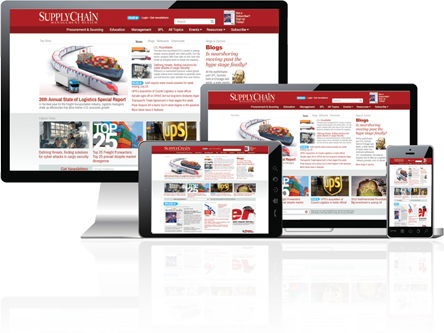Supply Chain Opportunity Costs about to Explode
Tariffs are survivable, if painful. Increasing opportunity costs or outright denying other countries opportunities is a much more dangerous game that, unfortunately, will prove the next challenge to supply chain managers.


Latest News
Supply Chain Services acquires Dasco Label Automated storage and retrieval system (ASRS) market worth $10.7 billion by 2025 Trucking comeback: Dohrn Transfer turns the corner with assist from Pitt Ohio JSCM Video: Managing buyer-supplier conflicts JSCM Video: Managing buyer-supplier conflicts More NewsLatest Resource
Simplifying Your End-to-End Supply Chain Download this report highlighting each point on the supply chain journey by explaining the role it plays, which includes the pain points you may face, what you should be thinking about at a particular stage in the journey, and what technology you can benefit from.
Download this report highlighting each point on the supply chain journey by explaining the role it plays, which includes the pain points you may face, what you should be thinking about at a particular stage in the journey, and what technology you can benefit from.
All Resources
The cost of tariffs gets a lot of popular media attention, but it’s a shallow treatment of a complex disease. Yesterday Bloomberg ran a piece titled, “The Age of Global Supply Chains Is in Trouble,” about the worrying impact of export restrictions on global supply chains.
As a former military officer, I’m all too aware of the correlation between warfare and countries needing access to resources and prosperity to take care of their people. It’s no coincidence that the wealth of the Industrial Revolution also gave rise to waves of deadly wars and conflicts. It’s hard for a government to placate poor and hungry people when they see neighboring countries who are better off.
Thanks to a world dominated by free trade, we take materials sciences and engineering for granted. But protectionism and tariffs’ greatest impacts are their opportunity costs. In the short run we can afford to pay a little extra for protectionism, yet in the long run they can deprive nations of important components of their livelihood. After all, money is fungible, but there are only a few places in the world to get fine wines, cheap rare earths, advanced microchips, or exotic supercars, no matter how deep your pockets.
For an example of the sorts of tensions and problems that can arise from tariffs and protectionism, look at the spat between South Korea and Japan. Japan is putting limits on exports of fluorinated polyimide, photo-resists, and hydrogen fluoride. Estimations assess Korean corporations now depend on Japan for over 90% of all the fluorinated polyimide and photo-resists, and 44% of its hydrogen fluoride. Samsung needs fluorinated polyimide for production of foldable panels (think Samsung’s Galaxy Fold), while photo-resists and hydrogen fluoride are needed for chip and display production. Some South Koreans have mounted demonstrations and boycotts against Japanese companies.
The Fourth Industrial Revolution is about to make these basic materials sciences and engineering much more important. As the Fourth Industrial Revolution alleviates the bottlenecks of interconnectivity, integration, and agility, but it is making countries realize how important access to materials has become. If you were in China’s shoes, watching how much profit Apple makes off of each iPhone compared to how much goes to China where much iPhone assembly occurs, you’d probably lose a little faith in the international trade system too. Clearly controlling key technologies matters to wealth and prosperity.
Tariffs are survivable, if painful. Increasing opportunity costs or outright denying other countries opportunities is a much more dangerous game that, unfortunately, will prove the next challenge to supply chain managers.
Past technological shifts have nearly always led to conflict as wealthier countries tend to throw their weight around, and inequality provokes innate human competitive instincts. Hopefully if enough people speak up, we can change our policies, but probably prudent to assume the worst.

About the Author
 Michael Gravier
Michael Gravier is a Professor of Marketing and Supply Chain Management at Bryant University with a focus on logistics, supply chain management and strategy and international trade. Follow Bryant University on Facebook and Twitter.
Michael Gravier
Michael Gravier is a Professor of Marketing and Supply Chain Management at Bryant University with a focus on logistics, supply chain management and strategy and international trade. Follow Bryant University on Facebook and Twitter.

Subscribe to Supply Chain Management Review Magazine!
Subscribe today. Don't Miss Out!Get in-depth coverage from industry experts with proven techniques for cutting supply chain costs and case studies in supply chain best practices.
Start Your Subscription Today!
 Simplifying Your End-to-End Supply Chain
Download this report highlighting each point on the supply chain journey by explaining the role it plays, which includes the pain points you may face, what you should be thinking about at a particular stage in the journey, and what technology you can benefit from.
Download Today!
Simplifying Your End-to-End Supply Chain
Download this report highlighting each point on the supply chain journey by explaining the role it plays, which includes the pain points you may face, what you should be thinking about at a particular stage in the journey, and what technology you can benefit from.
Download Today!
 When COVID-19 was bringing other supply chains to a screeching halt, AGCO acted early and decisively to keep its operations around the world up and running. The key: A very agile supply chain.
When COVID-19 was bringing other supply chains to a screeching halt, AGCO acted early and decisively to keep its operations around the world up and running. The key: A very agile supply chain.
Supply Chain Management is not enough Risk Management in an Era of Extreme Uncertainty View More From this Issue
 Master Your Supply Chain with an Intelligent Control Tower
Today’s control towers provide powerful capabilities and real-time responsiveness with Autonomous Problem-Solving, Global Demand-Supply Matching and Global Available-to-Promise.
Register Today!
Master Your Supply Chain with an Intelligent Control Tower
Today’s control towers provide powerful capabilities and real-time responsiveness with Autonomous Problem-Solving, Global Demand-Supply Matching and Global Available-to-Promise.
Register Today!











